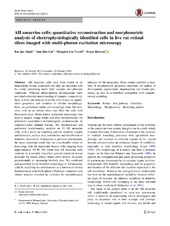AII amacrine cells: quantitative reconstruction and morphometric analysis of electrophysiologically identified cells in live rat retinal slices imaged with multi-photon excitation microscopy
Peer reviewed, Journal article
Published version

Åpne
Permanent lenke
https://hdl.handle.net/1956/15659Utgivelsesdato
2016-02Metadata
Vis full innførselSamlinger
Originalversjon
https://doi.org/10.1007/s00429-016-1206-0Sammendrag
AII amacrine cells have been found in all mammalian retinas examined and play an important role for visual processing under both scotopic and photopic conditions. Whereas ultrastructural investigations have provided a detailed understanding of synaptic connectivity, there is little information available with respect to quantitative properties and variation of cellular morphology. Here, we performed whole-cell recordings from AII amacrine cells in rat retinal slices and filled the cells with fluorescent dyes. Multi-photon excitation microscopy was used to acquire image stacks and after deconvolution, we performed quantitative morphological reconstruction by computer-aided manual tracing. We reconstructed and performed morphometric analysis on 43 AII amacrine cells, with a focus on branching pattern, dendritic lengths and diameters, surface area, and number and distribution of dendritic varicosities. Compared to previous descriptions, the most surprising result was the considerable extent of branching, with the maximum branch order ranging from approximately 10–40. We found that AII amacrine cells conform to a recently described general structural design principle for neural arbors, where arbor density decreases proportionally to increasing territory size. We confirmed and quantified the bi-stratified morphology of AII amacrine cells by analyzing the arborizations as a function of retinal localization or with Sholl spheres. Principal component and cluster analysis revealed no evidence for morphological subtypes of AII amacrines. These results establish a database of morphometric properties important for studies of development, regeneration, degeneration, and disease processes, as well as a workflow compatible with compartmental modeling.
